Differential Expression of miRNAs and Behavioral Change in the Cuprizone-Induced Demyelination Mouse Model
Abstract
:1. Introduction
2. Results
2.1. Cuprizone Causes Weight Loss Which Subsides after Returning to a Normal Diet
2.2. Cuprizone Increases the Number of Falls in the Rotarod Test
2.3. Cuprizone Decreases the Grip Strength of Mice
2.4. Cuprizone Decreases the Total Distance Traveled by Mice in the Open-Field Test
2.5. Cuprizone Induces a Loss of Myelin in the Corpus Callosum
2.6. Diverse Expression Patterns of microRNAs in Cuprizone-Induced Demyelination
2.7. Validation of miRNAs Expression Using the miRNA Quantitation PCR
2.8. Analysis of miRNA Target Genes and Signal Cascades in Cuprizone-Induced Demyelination
3. Discussion
4. Materials and Methods
4.1. Animals and Cuprizone Administration
4.2. Motor Coordination and Learning: Rotarod Test
4.3. Grip Strength Test
4.4. Open-Field Assessment
4.5. Luxol Fast Blue Staining and Myelin Basic Protein Immunohistochemistry
4.6. RNA Isolation and RNA Quality Check for Affymetrix miRNA Arrays
4.7. Affymetrix miRNA Arrays
4.8. Raw Data Preparation and Statistical Analysis of Affymetrix miRNA Arrays
4.9. Statistical Analysis
4.10. Real-Time PCR for miRNA Quantitation and Target Genes of miRNAs
4.11. Western Blot Analysis
5. Conclusions
Supplementary Materials
Author Contributions
Funding
Acknowledgments
Conflicts of Interest
Ethical Approval
Data Availability
References
- Compston, A.; Coles, A. Multiple sclerosis. Lancet 2008, 372, 1502–1517. [Google Scholar] [CrossRef]
- Sen, M.K.; Mahns, D.A.; Coorssen, J.R.; Shortland, P.J. Behavioural phenotypes in the cuprizone model of central nervous system demyelination. Neurosci. Biobehav. Rev. 2019, 107, 23–46. [Google Scholar] [CrossRef] [PubMed]
- Lucchinetti, C.F.; Bruck, W.; Rodriguez, M.; Lassmann, H. Distinct patterns of multiple sclerosis pathology indicates heterogeneity on pathogenesis. Brain Pathol. 1996, 6, 259–274. [Google Scholar] [CrossRef] [PubMed]
- Lucchinetti, C.; Bruck, W.; Parisi, J.; Scheithauer, B.; Rodriguez, M.; Lassmann, H. Heterogeneity of multiple sclerosis lesions: Implications for the pathogenesis of demyelination. Ann. Neurol. 2000, 47, 707–717. [Google Scholar] [CrossRef]
- Patrikios, P.; Stadelmann, C.; Kutzelnigg, A.; Rauschka, H.; Schmidbauer, M.; Laursen, H.; Sorensen, P.S.; Bruck, W.; Lucchinetti, C.; Lassmann, H. Remyelination is extensive in a subset of multiple sclerosis patients. Brain 2006, 129, 3165–3172. [Google Scholar] [CrossRef] [PubMed] [Green Version]
- Goldschmidt, T.; Antel, J.; Konig, F.B.; Bruck, W.; Kuhlmann, T. Remyelination capacity of the MS brain decreases with disease chronicity. Neurology 2009, 72, 1914–1921. [Google Scholar] [CrossRef]
- Sen, M.K.; Almuslehi, M.S.M.; Gyengesi, E.; Myers, S.J.; Shortland, P.J.; Mahns, D.A.; Coorssen, J.R. Suppression of the Peripheral Immune System Limits the Central Immune Response Following Cuprizone-Feeding: Relevance to Modelling Multiple Sclerosis. Cells 2019, 8, 1314. [Google Scholar] [CrossRef]
- Liu, L.; Belkadi, A.; Darnall, L.; Hu, T.; Drescher, C.; Cotleur, A.C.; Padovani-Claudio, D.; He, T.; Choi, K.; Lane, T.E.; et al. CXCR2-positive neutrophils are essential for cuprizone-induced demyelination: Relevance to multiple sclerosis. Nat. Neurosci. 2010, 13, 319–326. [Google Scholar] [CrossRef]
- Pasquini, L.A.; Calatayud, C.A.; Bertone Una, A.L.; Millet, V.; Pasquini, J.M.; Soto, E.F. The neurotoxic effect of cuprizone on oligodendrocytes depends on the presence of pro-inflammatory cytokines secreted by microglia. Neurochem. Res. 2007, 32, 279–292. [Google Scholar] [CrossRef]
- Suzuki, K.; Kikkawa, Y. Status spongiosus of CNS and hepatic changes induced by cuprizone (biscyclohexanone oxalyldihydrazone). Am. J. Pathol. 1969, 54, 307–325. [Google Scholar]
- Skripuletz, T.; Lindner, M.; Kotsiari, A.; Garde, N.; Fokuhl, J.; Linsmeier, F.; Trebst, C.; Stangel, M. Cortical demyelination is prominent in the murine cuprizone model and is strain-dependent. Am. J. Pathol. 2008, 172, 1053–1061. [Google Scholar] [CrossRef] [PubMed] [Green Version]
- Taylor, L.C.; Gilmore, W.; Matsushima, G.K. SJL mice exposed to cuprizone intoxication reveal strain and gender pattern differences in demyelination. Brain Pathol. 2009, 19, 467–479. [Google Scholar] [CrossRef] [PubMed]
- Taylor, L.C.; Gilmore, W.; Ting, J.P.; Matsushima, G.K. Cuprizone induces similar demyelination in male and female C57BL/6 mice and results in disruption of the estrous cycle. J. Neurosci. Res. 2010, 88, 391–402. [Google Scholar] [CrossRef] [PubMed]
- Gudi, V.; Moharregh-Khiabani, D.; Skripuletz, T.; Koutsoudaki, P.N.; Kotsiari, A.; Skuljec, J.; Trebst, C.; Stangel, M. Regional differences between grey and white matter in cuprizone induced demyelination. Brain Res. 2009, 1283, 127–138. [Google Scholar] [CrossRef]
- Stidworthy, M.F.; Genoud, S.; Suter, U.; Mantei, N.; Franklin, R.J. Quantifying the early stages of remyelination following cuprizone-induced demyelination. Brain Pathol. 2003, 13, 329–339. [Google Scholar] [CrossRef]
- Kipp, M.; Clarner, T.; Dang, J.; Copray, S.; Beyer, C. The cuprizone animal model: New insights into an old story. Acta Neuropathol. 2009, 118, 723–736. [Google Scholar] [CrossRef]
- Hiremath, M.M.; Saito, Y.; Knapp, G.W.; Ting, J.P.; Suzuki, K.; Matsushima, G.K. Microglial/macrophage accumulation during cuprizone-induced demyelination in C57BL/6 mice. J. Neuroimmunol. 1998, 92, 38–49. [Google Scholar] [CrossRef]
- Koutsoudaki, P.N.; Skripuletz, T.; Gudi, V.; Moharregh-Khiabani, D.; Hildebrandt, H.; Trebst, C.; Stangel, M. Demyelination of the hippocampus is prominent in the cuprizone model. Neurosci. Lett. 2009, 451, 83–88. [Google Scholar] [CrossRef]
- Pott, F.; Gingele, S.; Clarner, T.; Dang, J.; Baumgartner, W.; Beyer, C.; Kipp, M. Cuprizone effect on myelination, astrogliosis and microglia attraction in the mouse basal ganglia. Brain Res. 2009, 1305, 137–149. [Google Scholar] [CrossRef]
- Blakemore, W.F. Demyelination of the superior cerebellar peduncle in the mouse induced by cuprizone. J. Neurol. Sci. 1973, 20, 63–72. [Google Scholar] [CrossRef]
- Ludwin, S.K. Central nervous system demyelination and remyelination in the mouse: An ultrastructural study of cuprizone toxicity. Lab. Investig. J. Tech. Methods Pathol. 1978, 39, 597–612. [Google Scholar]
- Groebe, A.; Clarner, T.; Baumgartner, W.; Dang, J.; Beyer, C.; Kipp, M. Cuprizone treatment induces distinct demyelination, astrocytosis, and microglia cell invasion or proliferation in the mouse cerebellum. Cerebellum 2009, 8, 163–174. [Google Scholar] [CrossRef] [PubMed]
- Skripuletz, T.; Bussmann, J.H.; Gudi, V.; Koutsoudaki, P.N.; Pul, R.; Moharregh-Khiabani, D.; Lindner, M.; Stangel, M. Cerebellar cortical demyelination in the murine cuprizone model. Brain Pathol. 2010, 20, 301–312. [Google Scholar] [CrossRef] [PubMed]
- Matsushima, G.K.; Morell, P. The neurotoxicant, cuprizone, as a model to study demyelination and remyelination in the central nervous system. Brain Pathol. 2001, 11, 107–116. [Google Scholar] [CrossRef] [PubMed]
- Blakemore, W.F. Observations on oligodendrocyte degeneration, the resolution of status spongiosus and remyelination in cuprizone intoxication in mice. J. Neurocytol. 1972, 1, 413–426. [Google Scholar] [CrossRef] [PubMed]
- Bando, Y.; Takakusaki, K.; Ito, S.; Terayama, R.; Kashiwayanagi, M.; Yoshida, S. Differential changes in axonal conduction following CNS demyelination in two mouse models. Eur. J. Neurosci. 2008, 28, 1731–1742. [Google Scholar] [CrossRef] [PubMed] [Green Version]
- Duncan, I.D.; Brower, A.; Kondo, Y.; Curlee, J.F., Jr.; Schultz, R.D. Extensive remyelination of the CNS leads to functional recovery. Proc. Natl. Acad. Sci. USA 2009, 106, 6832–6836. [Google Scholar] [CrossRef] [Green Version]
- Irvine, K.A.; Blakemore, W.F. Remyelination protects axons from demyelination-associated axon degeneration. Brain 2008, 131, 1464–1477. [Google Scholar] [CrossRef] [Green Version]
- Arnett, H.A.; Mason, J.; Marino, M.; Suzuki, K.; Matsushima, G.K.; Ting, J.P. TNF alpha promotes proliferation of oligodendrocyte progenitors and remyelination. Nat. Neurosci. 2001, 4, 1116–1122. [Google Scholar] [CrossRef]
- Mi, S.; Miller, R.H.; Tang, W.; Lee, X.; Hu, B.; Wu, W.; Zhang, Y.; Shields, C.B.; Zhang, Y.; Miklasz, S.; et al. Promotion of central nervous system remyelination by induced differentiation of oligodendrocyte precursor cells. Ann. Neurol. 2009, 65, 304–315. [Google Scholar] [CrossRef]
- Plant, S.R.; Arnett, H.A.; Ting, J.P. Astroglial-derived lymphotoxin-alpha exacerbates inflammation and demyelination, but not remyelination. Glia 2005, 49, 1–14. [Google Scholar] [CrossRef] [PubMed]
- Li, Y.; Wu, P.; Liang, F.; Huang, W. The microstructural status of the corpus callosum is associated with the degree of motor function and neurological deficit in stroke patients. PLoS ONE 2015, 10, e0122615. [Google Scholar] [CrossRef] [PubMed] [Green Version]
- Ghadiri, N.; Emamnia, N.; Ganjalikhani-Hakemi, M.; Ghaedi, K.; Etemadifar, M.; Salehi, M.; Shirzad, H.; Nasr-Esfahani, M.H. Analysis of the expression of mir-34a, mir-199a, mir-30c and mir-19a in peripheral blood CD4+T lymphocytes of relapsing-remitting multiple sclerosis patients. Gene 2018, 659, 109–117. [Google Scholar] [CrossRef] [PubMed]
- Vistbakka, J.; Sumelahti, M.L.; Lehtimaki, T.; Elovaara, I.; Hagman, S. Evaluation of serum miR-191-5p, miR-24-3p, miR-128-3p, and miR-376c-3 in multiple sclerosis patients. Acta Neurol. Scand. 2018, 138, 130–136. [Google Scholar] [CrossRef] [PubMed]
- Kang, Y.H.; Han, S.R.; Jeon, H.; Lee, S.; Lee, J.; Yoo, S.M.; Park, J.B.; Park, M.J.; Kim, J.T.; Lee, H.G.; et al. Nogo receptor-vimentin interaction: A novel mechanism for the invasive activity of glioblastoma multiforme. Exp. Mol. Med. 2019, 51, 125. [Google Scholar] [CrossRef] [PubMed] [Green Version]
- Prineas, J.W. Pathology of inflammatory demyelinating neuropathies. Bailliere’s Clin. Neurol. 1994, 3, 1–24. [Google Scholar]
- Morell, P.; Barrett, C.V.; Mason, J.L.; Toews, A.D.; Hostettler, J.D.; Knapp, G.W.; Matsushima, G.K. Gene expression in brain during cuprizone-induced demyelination and remyelination. Mol. Cell Neurosci. 1998, 12, 220–227. [Google Scholar] [CrossRef]
- Franco-Pons, N.; Torrente, M.; Colomina, M.T.; Vilella, E. Behavioral deficits in the cuprizone-induced murine model of demyelination/remyelination. Toxicol. Lett. 2007, 169, 205–213. [Google Scholar] [CrossRef]
- Xiao, C.; Rajewsky, K. MicroRNA control in the immune system: Basic principles. Cell 2009, 136, 26–36. [Google Scholar] [CrossRef] [Green Version]
- Wang, Y.; Juranek, S.; Li, H.; Sheng, G.; Wardle, G.S.; Tuschl, T.; Patel, D.J. Nucleation, propagation and cleavage of target RNAs in Ago silencing complexes. Nature 2009, 461, 754–761. [Google Scholar] [CrossRef]
- Jinek, M.; Doudna, J.A. A three-dimensional view of the molecular machinery of RNA interference. Nature 2009, 457, 405–412. [Google Scholar] [CrossRef] [PubMed]
- Selbach, M.; Schwanhausser, B.; Thierfelder, N.; Fang, Z.; Khanin, R.; Rajewsky, N. Widespread changes in protein synthesis induced by microRNAs. Nature 2008, 455, 58–63. [Google Scholar] [CrossRef]
- Talebi, F.; Ghorbani, S.; Chan, W.F.; Boghozian, R.; Masoumi, F.; Ghasemi, S.; Vojgani, M.; Power, C.; Noorbakhsh, F. MicroRNA-142 regulates inflammation and T cell differentiation in an animal model of multiple sclerosis. J. Neuroinflamm. 2017, 14, 55. [Google Scholar] [CrossRef] [PubMed] [Green Version]
- Fan, H.B.; Chen, L.X.; Qu, X.B.; Ren, C.L.; Wu, X.X.; Dong, F.X.; Zhang, B.L.; Gao, D.S.; Yao, R.Q. Transplanted miR-219-overexpressing oligodendrocyte precursor cells promoted remyelination and improved functional recovery in a chronic demyelinated model. Sci. Rep. 2017, 7, 41407. [Google Scholar] [CrossRef] [PubMed] [Green Version]
- Hoye, M.L.; Archambault, A.S.; Gordon, T.M.; Oetjen, L.K.; Cain, M.D.; Klein, R.S.; Crosby, S.D.; Kim, B.S.; Miller, T.M.; Wu, G.F. MicroRNA signature of central nervous system-infiltrating dendritic cells in an animal model of multiple sclerosis. Immunology 2018, 155, 112–122. [Google Scholar] [CrossRef] [PubMed] [Green Version]
- Mycko, M.P.; Cichalewska, M.; Cwiklinska, H.; Selmaj, K.W. miR-155-3p Drives the Development of Autoimmune Demyelination by Regulation of Heat Shock Protein 40. J. Neurosci. Off. J. Soc. Neurosci. 2015, 35, 16504–16515. [Google Scholar] [CrossRef] [Green Version]
- Chiang, H.R.; Schoenfeld, L.W.; Ruby, J.G.; Auyeung, V.C.; Spies, N.; Baek, D.; Johnston, W.K.; Russ, C.; Luo, S.; Babiarz, J.E.; et al. Mammalian microRNAs: Experimental evaluation of novel and previously annotated genes. Genes Dev. 2010, 24, 992–1009. [Google Scholar] [CrossRef] [Green Version]
- O’Connell, R.M.; Kahn, D.; Gibson, W.S.; Round, J.L.; Scholz, R.L.; Chaudhuri, A.A.; Kahn, M.E.; Rao, D.S.; Baltimore, D. MicroRNA-155 promotes autoimmune inflammation by enhancing inflammatory T cell development. Immunity 2010, 33, 607–619. [Google Scholar] [CrossRef] [Green Version]
- Murugaiyan, G.; Beynon, V.; Mittal, A.; Joller, N.; Weiner, H.L. Silencing microRNA-155 ameliorates experimental autoimmune encephalomyelitis. J. Immunol. 2011, 187, 2213–2221. [Google Scholar] [CrossRef] [Green Version]
- Zhang, J.; Zhang, Z.G.; Lu, M.; Wang, X.; Shang, X.; Elias, S.B.; Chopp, M. MiR-146a promotes remyelination in a cuprizone model of demyelinating injury. Neuroscience 2017, 348, 252–263. [Google Scholar] [CrossRef]
- Martin, N.A.; Molnar, V.; Szilagyi, G.T.; Elkjaer, M.L.; Nawrocki, A.; Okarmus, J.; Wlodarczyk, A.; Thygesen, E.K.; Palkovits, M.; Gallyas, F., Jr.; et al. Experimental Demyelination and Axonal Loss Are Reduced in MicroRNA-146a Deficient Mice. Front. Immunol. 2018, 9, 490. [Google Scholar] [CrossRef] [PubMed] [Green Version]
- Wahl, M.; Lauterbach-Soon, B.; Hattingen, E.; Jung, P.; Singer, O.; Volz, S.; Klein, J.C.; Steinmetz, H.; Ziemann, U. Human motor corpus callosum: Topography, somatotopy, and link between microstructure and function. J. Neurosci. Off. J. Soc. Neurosci. 2007, 27, 12132–12138. [Google Scholar] [CrossRef] [PubMed] [Green Version]
- Tomas-Roig, J.; Wirths, O.; Salinas-Riester, G.; Havemann-Reinecke, U. The Cannabinoid CB1/CB2 Agonist WIN55212.2 Promotes Oligodendrocyte Differentiation In Vitro and Neuroprotection During the Cuprizone-Induced Central Nervous System Demyelination. CNS Neurosci. Ther. 2016, 22, 387–395. [Google Scholar] [CrossRef] [PubMed] [Green Version]
- Mi, S.; Miller, R.H.; Lee, X.; Scott, M.L.; Shulag-Morskaya, S.; Shao, Z.; Chang, J.; Thill, G.; Levesque, M.; Zhang, M.; et al. LINGO-1 negatively regulates myelination by oligodendrocytes. Nat. Neurosci. 2005, 8, 745–751. [Google Scholar] [CrossRef]
- Petratos, S.; Azari, M.F.; Ozturk, E.; Papadopoulos, R.; Bernard, C.C. Novel therapeutic targets for axonal degeneration in multiple sclerosis. J. Neuropathol. Exp. Neurol. 2010, 69, 323–334. [Google Scholar] [CrossRef] [Green Version]
- Steelman, A.J.; Thompson, J.P.; Li, J. Demyelination and remyelination in anatomically distinct regions of the corpus callosum following cuprizone intoxication. Neurosci. Res. 2012, 72, 32–42. [Google Scholar] [CrossRef] [Green Version]
- Jeon, H.; Han, S.R.; Lee, S.; Park, S.J.; Kim, J.H.; Yoo, S.M.; Lee, M.S. Activation of the complement system in an osteosarcoma cell line promotes angiogenesis through enhanced production of growth factors. Sci. Rep. 2018, 8, 5415. [Google Scholar] [CrossRef]
- Underhill, H.R.; Rostomily, R.C.; Mikheev, A.M.; Yuan, C.; Yarnykh, V.L. Fast bound pool fraction imaging of the in vivo rat brain: Association with myelin content and validation in the C6 glioma model. NeuroImage 2011, 54, 2052–2065. [Google Scholar] [CrossRef] [Green Version]
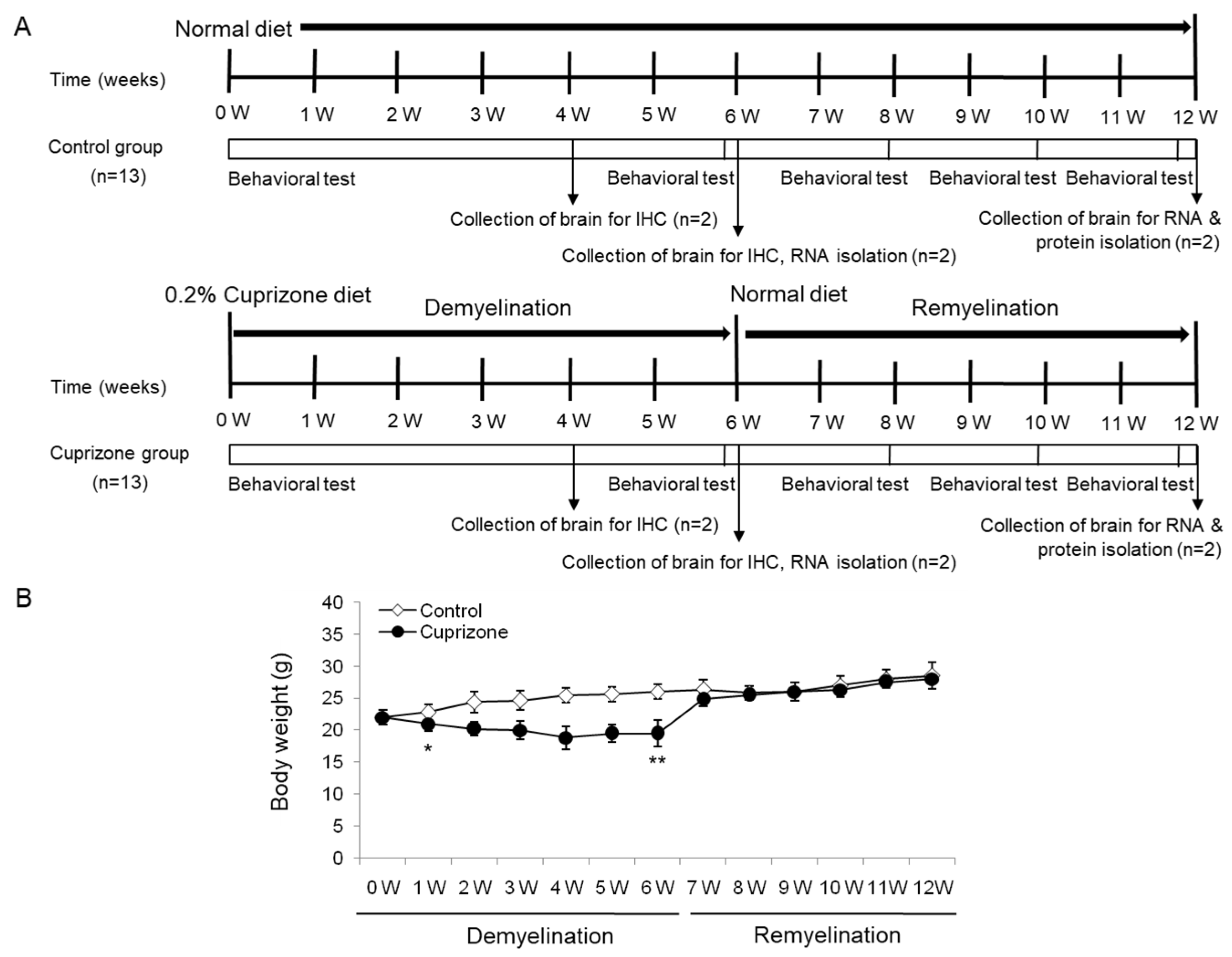
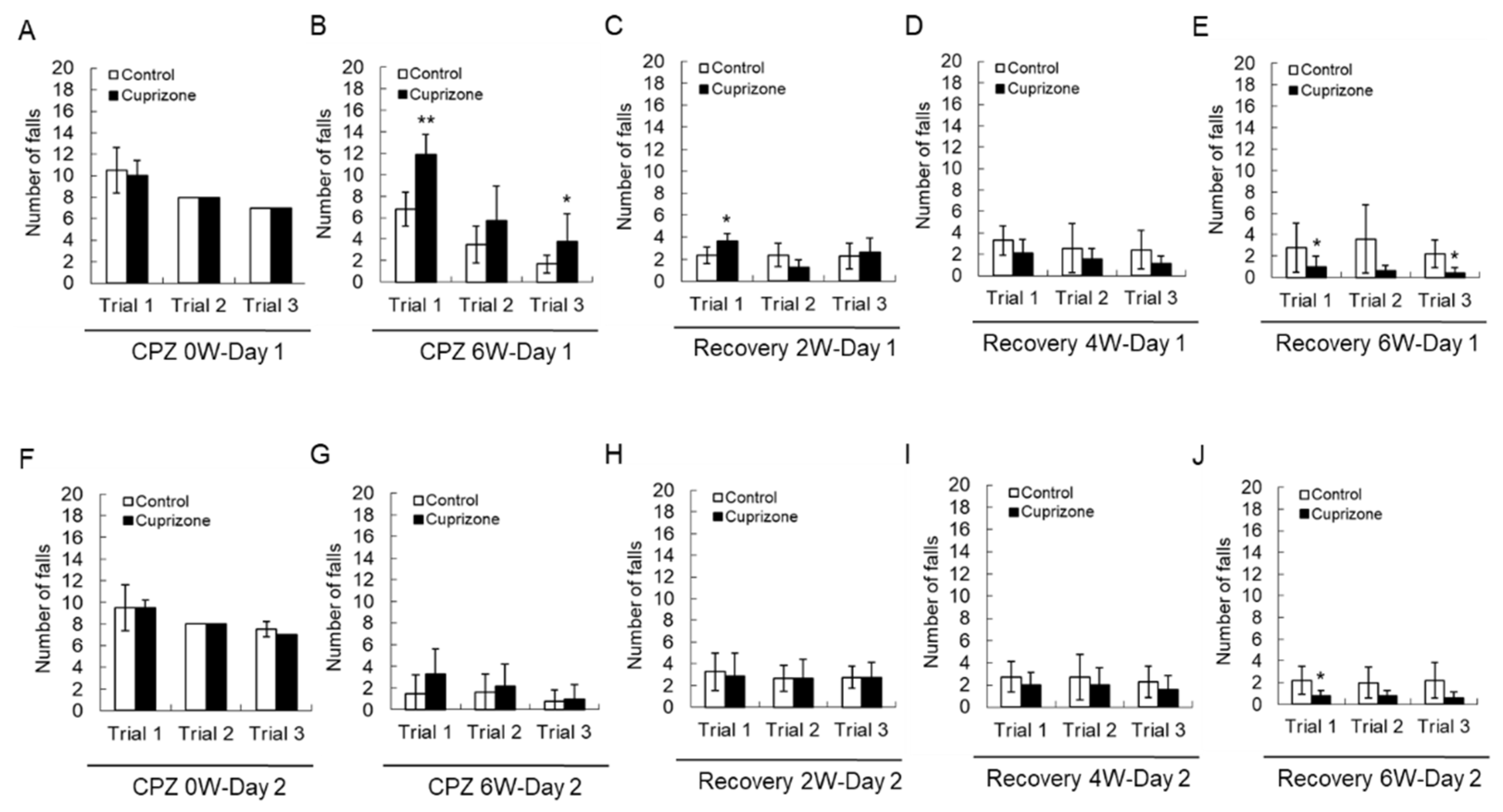
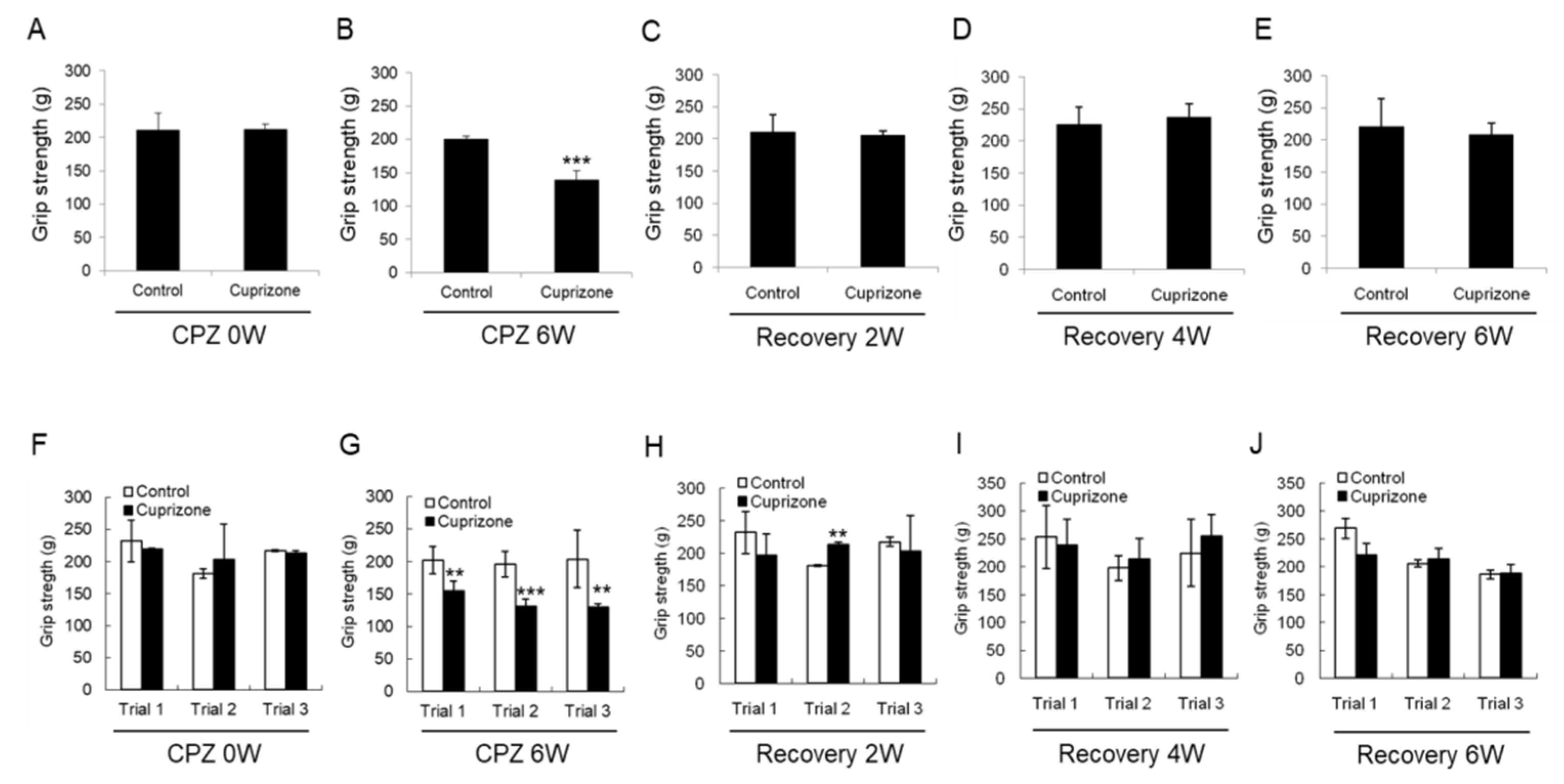



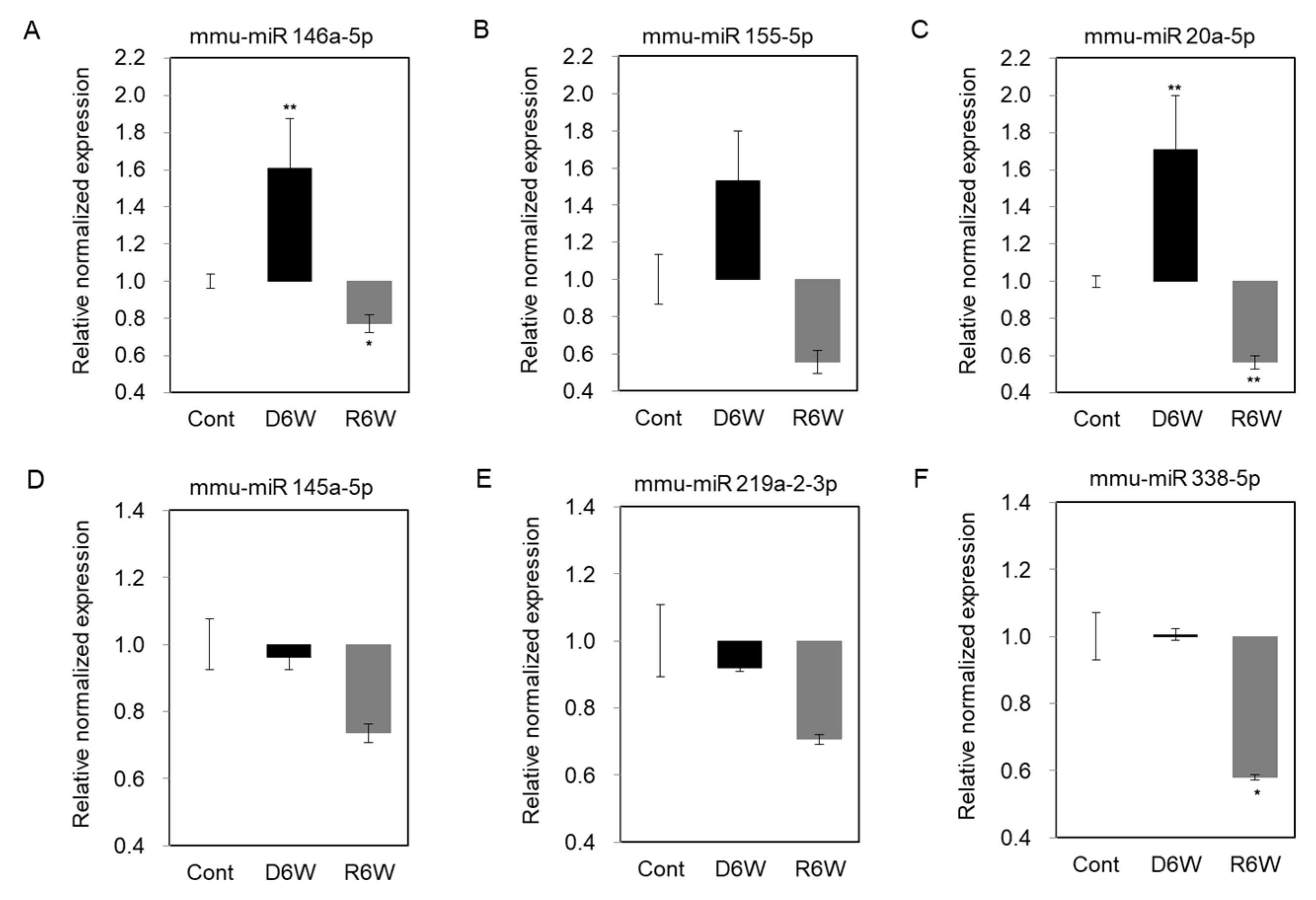

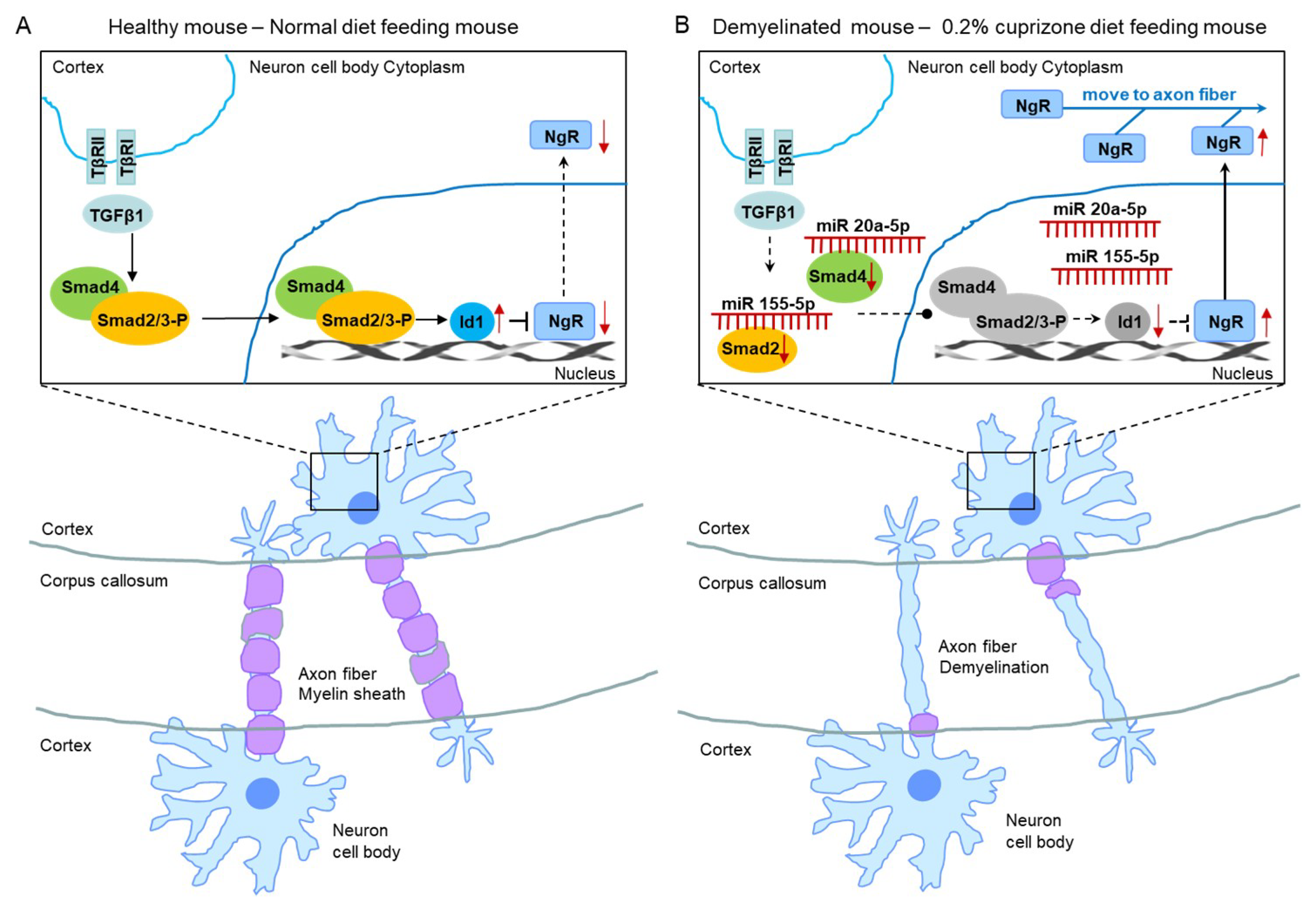
| Transcript ID (Array Design) | CPZ_5/Control.fc | CPZ_5/Control.volume | Predicted Targets in miRDB | Sequence Length | Sequence |
|---|---|---|---|---|---|
| mmu-miR-146a-5p | 2.707892 | 7.386574 | Nova1, Golph3l, Eif4g2, Slc10a3, Kras, Usp3, Irak1 | 22 | UGAGAACUGAAUUCCAUGGGUU |
| mmu-miR-20a-5p | 1.894162 | 6.941493 | Tnfrsf21, Map3k2, Rab5b, Arhgap12, E2f1, Arhgap1, Tgfbr2, Fzd3/5, Smad4/5/7, CXCL12, Ccnd1, Cadm2 | 23 | UAAAGUGCUUAUAGUGCAGGUAG |
| mmu-miR-34c-5p | 1.919406 | 6.30073 | Vamp2, Notch1, E2f5, Il6ra, Ubl4, Rtn4rl1, Cx3cl1 | 23 | AGGCAGUGUAGUUAGCUGAUUGC |
| mmu-miR-431-5p | 1.836794 | 6.098394 | Zfp644, Smurf1, CD34, Camta1, Cltc, Ctsb, Zeb1, Lamp2, Smad4 | 21 | UGUCUUGCAGGCCGUCAUGCA |
| mmu-miR-146b-5p | 1.586426 | 5.961954 | Nova1, Golph3l, Eif4g2, Bcorl1, Kras, Usp3, Irak1, Psmd3 | 22 | UGAGAACUGAAUUCCAUAGGCU |
| mmu-miR-203-3p | 1.898645 | 5.216835 | Ptp4a1, Gabarapl1, Tbk1, Nova1, Ubr1, Ctss, Rab10, Cdh10, Rtn4(ts88%) | 22 | GUGAAAUGUUUAGGACCACUAG |
| mmu-miR-665-3p | 1.588351 | 5.094984 | Hars2, Stk35, Il1r1, Abr, Eno2, Ncam1, Syn1, Fgfr1, Edem1, Sumo1 | 20 | ACCAGGAGGCUGAGGUCCCU |
| mmu-miR-7a-5p | 2.651576 | 5.018355 | Sp1, Cdon, Casp9, Ide, Mapkap1, Mobp(94%), Edem1, Vdac1, Mapk8 | 23 | UGGAAGACUAGUGAUUUUGUUGU |
| mmu-miR-17-3p | 1.785589 | 4.874162 | Adam7, Vezf1, Rab35, Neurog1, Apaf1, Hdac3, Golim4, Cdk17, Vim(74%) | 22 | ACUGCAGUGAGGGCACUUGUAG |
| mmu-miR-1946b | 2.028228 | 4.81781 | Rac2, Ctsa, Cnnm3, IL34, Tnfrsf10b | 26 | GCCGGGCAGUGGUGGCACAUGCUUUU |
| mmu-miR-6980-5p | 1.623165 | 4.770035 | Pip5k1c, Pgap3,Crispld2, Mcl1, Cadm4, Nova2, Mapkap1, Cdk4 | 22 | GUGGGGGGGGAGGCUAGGUUAG |
| mmu-miR-7648-3p | 1.884263 | 4.431739 | sp1, Cdon, Casp9, Ide, Mapkap1, Mobp(94%), Edem1, Vdac1, Mapk8 | 21 | AGGGCUGGGCCCGGGACGCGG |
| mmu-miR-6970-5p | 1.606978 | 4.332724 | Cldn25, Cstc, Hars2, Tgfb2, Dek, Cd2ap, Ccnc(cyclin c), Paxip1, Pi15, Necap1, Usp3 | 25 | GUAAGUUCAGGGCUGGGAGCAGAGA |
| mmu-mir-665 | 1.584525 | 4.221859 | 3p:Hars2, Cipc, Tgfb3, Klk9, Cxcl1, Sdc1, Cadm3, Smad7, Tgfbr1, Dnm1 | 94 | AGAACAGGGUCUCCUUGAGGGGCCUCUGCCUCUAUCCAGGAUUAUGUUUUUAUGACCAGGAGGCUGAGGUCCCUUACAGGCGGCCUCUUACUCU |
| mmu-miR-380-5p | 1.54359 | 4.158481 | Frk, Socs2, Snai2, Neurod1, Il33, Nkiras1, Tgfbr2, Sp3, Rb1, Ccr7, smad5, Bmp4 | 22 | AUGGUUGACCAUAGAACAUGCG |
| mmu-miR-125b-2-3p | 2.096336 | 4.139472 | Cd28, Dab2, Stim2, Scai, Frk, Api5, Ret, Nedd9, H3f3b, Gga3, Tab2, Vcam1 | 22 | ACAAGUCAGGUUCUUGGGACCU |
| mmu-miR-7066-3p | 1.705388 | 4.096965 | Tnfaip2, Mtss1, Nrcam, H3f3b, Ergic1, Moap1, Mcam | 23 | UCUACCCAUUGCCUGCCUCCCAG |
| mmu-miR-195a-3p | 1.690828 | 4.045272 | Mbp(54%), Cnr1, Ube2i, Hif1a, Nedd9, Negr1, Hand2, Cadm2, Id1, Rab1, Cebpd, Lingo2 | 22 | CCAAUAUUGGCUGUGCUGCUCC |
| mmu-miR-1949 | 2.231649 | 3.982245 | Ubr3,Hif1a, Trim2, Taok1, Tgfbrap1, Rb1, Tgfb2 | 24 | CUAUACCAGGAUGUCAGCAUAGUU |
| mmu-miR-6952-3p | 3.362607 | 3.965036 | Cemip, Rab1, Nova1, Lingo2, Nomo1, Ikbkb, Mtus1, MMP20, Sp1, Cdk1 | 22 | UCUCUGACUCUGCCUCCCACAG |
| mmu-miR-433-5p | 1.776922 | 3.873063 | Smad3, Pak3, Nav2, Smad9, Il1r1, Cdk12 | 22 | UACGGUGAGCCUGUCAUUAUUC |
| mmu-mir-3069 | 1.598601 | 3.821933 | Crem, Lamp5, Api5, Mbp(77%), Neta1 | 65 | CUUGGCAGUCAAGAUAUUGUUUAGCAGACGGAGCGGUUUCUGUUGGACACUAAGUACUGCCACAA |
| mmu-miR-350-3p | 2.117072 | 3.709891 | Epcam, Pak6, CD163, Ilf3, Ctbp1, Mdh, E2f5, Gbas, Cxxc5, Mapk9, Nedd9 | 22 | UUCACAAAGCCCAUACACUUUC |
| mmu-miR-539-5p | 1.709518 | 3.523559 | Mpz(56%), Smad5(52%), Enc1, Gas2, Map3k2, Cd44, Sp1, Dab2, Egfr | 22 | GGAGAAAUUAUCCUUGGUGUGU |
| mmu-miR-155-5p | 6.260639 | 3.361842 | Nova1, Cebpb, Smad2(85%), Tab2, Hif1a, Kras, Il6ra, E2f2, Il7r | 23 | UUAAUGCUAAUUGUGAUAGGGGU |
| mmu-miR-7050-5p | 1.581792 | 3.325942 | Cxcl16, Cdc14b, Ikbkb, Vdr, Nrg3, Map3k9, Nav1, Usp7, Scai, Cxcl14, Tgfb2, Smad2(52%) | 21 | ACAGGAGAAGGGGGUGAGAGA |
| mmu-miR-412-3p | 2.145554 | 3.249526 | Rims2, Clock, Mapk9, Taok1, Cdc42, Hip1, Tgfb3 | 20 | UUCACCUGGUCCACUAGCCG |
| mmu-miR-6910-5p | 1.835852 | 3.243152 | Irs1, Lrrc36, Neurog1, Mpzl2, Cnnm1, CD40lg | 23 | UGGGGGUAGGGCACCAGUGGGCA |
| mmu-miR-6971-5p | 2.145539 | 3.175284 | Myrf, Map4, Vamp2, Taok3, Gas7, Notch4, Sp1, Nav2, Cadm4, Nova2, Neurog2, Lingo1, Wnt3, Sox9, Cadm3, Sp2, Ndrg2, Casp9, Il25, Cstb, Cd69, Notch1, Runx1, Cd7, Cx3cl1, Neurog1, Notch3 | 20 | UGGGGGAGGGUGUAGAGGCU |
| mmu-miR-7674-5p | 2.17967 | 3.059262 | Akt3, Cdh2, Cadm1, Il6ra, Cd37, Mpzl1 | 24 | UGAGGUGUGGGCAGCAUGAGGACU |
| mmu-miR-669a-5p | 2.361674 | 3.041107 | Cdk17, Has2, Bcor, Cdk13, Cd86, Bcl2, Cend1, Rad52, Tgfbrap1 | 24 | AGUUGUGUGUGCAUGUUCAUGUCU |
| mmu-miR-467d-3p | 3.182543 | 2.803507 | Rtn4(63%), Fgfr2, Tgfbr3, Bmper, Cxcl5, Ccnc, Tab2, Cxcl16, Smad9, Mpzl1 | 22 | AUAUACAUACACACACCUACAC |
| mmu-miR-199a-3p | 2.686187 | 2.772667 | Cd151, Nova1, Pak4, Fn1, Map3k4, Cdk17, Mal2, Sp1, Tack1, Rb1, Id4, Sumo3, Cxxc5, Mtor, Net1, Nedd4, Casp9, Vamp3, Bcl3 | 22 | ACAGUAGUCUGCACAUUGGUUA |
| mmu-miR-199b-3p | 2.686187 | 2.772667 | Cd151, Itga3, Serpine2, Sp1, Rb1, Sumo3, Cxxc5, Map3k5, Mtor, Ndrg1, Casp9, Tab3, Ccl7, Ceacam12 | 22 | ACAGUAGUCUGCACAUUGGUUA |
| mmu-miR-466a-3p | 1.584525 | 1.937278 | Omg(98%), Rtn4(84%), Smad7(80%), Smad1(78%), Mpzl1(78%), Cxcl1, Cxcl12, Cxcl16 | 23 | UAUACAUACACGCACACAUAAGA |
| mmu-miR-466e-3p | 1.584525 | 1.937278 | Omg(98%), Rtn4(84%), Smad1(78%), Mpzl1, Wnt3, Cxcl1, Esm1, Cxcl2, Ndrg4, Cxcl16 | 23 | UAUACAUACACGCACACAUAAGA |
| mmu-miR-467f | 2.979231 | 1.720809 | Gabrb3, Nova1, Ube2b, Mmp11, Mcam, Cxcl16, Smad7, Pten, Smad6, Zeb1, Smad9, Id2, Mcl1 | 21 | AUAUACACACACACACCUACA |
| mmu-miR-3087-5p | 1.624662 | 1.426936 | Hap1, Klk11, Gas7, Stim1, Lingo1(92%), Ncam2, Cxcl16, Cav1, Smad3, Smad10, Ceacam1, Runx3 | 21 | CAGGGCAGGGCAAGAGUUGAG |
| mmu-mir-466b-5 | 1.581792 | 0.824707 | Sp1, Bcor, Hdac9, B2m(62%), Cxcl12(57%), Cd53, Akt3, Neurod1, Api5 | 88 | UGUGUAUGUGUUGAUGUGUGUGUACAUGUACAUGUGUGAAUAUGAUAUACAUAUACAUACACGCACACAUAAGACACAUAUGAGCACA |
| Transcript ID (Array Design) | CPZ_5/Control.fc | CPZ_5/Control.volume | Predicted Targets in miRDB | Sequence Length | Sequence |
|---|---|---|---|---|---|
| mmu-miR-145a-5p | −1.55682 | 10.8367 | Mpzl2, Rin2, Myrf, Smad3(85%), Twist2, Socs7, Mpzl1, Tgfa | 23 | GUCCAGUUUUCCCAGGAAUCCCU |
| mmu-miR-219a-2-3p | −2.83282 | 8.879056 | Mthfd2l, Mapk8, Sdc2, Plk2, Cd36 | 22 | AGAAUUGUGGCUGGACAUCUGU |
| mmu-miR-338-5p | −1.5951 | 7.399533 | wif1, Cav2, Nedd1, Chl1, Sox6, Sp2, Snai1, Fasl, nanog, Tgfbr1 | 22 | AACAAUAUCCUGGUGCUGAGUG |
| mmu-miR-200c-3p | −49.2278 | 6.603223 | Zeb1, Zeb2, Nova1, Cdk17, Tbk1, jun, Mdm4, Vegfa, Ets1, Hif1a, Il17a, Mmp12, Casp2, Sdc2 | 23 | UAAUACUGCCGGGUAAUGAUGGA |
| mmu-miR-182-5p | −53.6342 | 6.358183 | Mtss1, Smad1, Bnip3, Vamp3, L1cam, Bmper, Mmp8, Smad4, Olig3, Rtn4(62%), Bdnf | 25 | UUUGGCAAUGGUAGAACUCACACCG |
| mmu-miR-700-5p | −1.5113 | 5.970658 | Nav2, Rb1, Notch1, Plk3, Scai, Mapk1, Smad1, Hdac7, Smad2 | 22 | UAAGGCUCCUUCCUGUGCUUGC |
| mmu-miR-7018-5p | −1.83096 | 5.038515 | Lingo2, Jak2, Cpm(carboxypeptidase M), Dnm3, Rb1, Il10ra | 24 | GUGAGCAGACAGGGAGUGGUGGGG |
| mmu-miR-206-3p | −1.95263 | 4.988861 | Ets1, Vamp2, Caap1, Hsp90b1, Cav2, Clock, Bdnf, E2f5, Sp2, Wnt3, Ndrg1, Mpl, Kras, Snai2, Nedd9 | 22 | UGGAAUGUAAGGAAGUGUGUGG |
| mmu-miR-484 | −1.70343 | 4.967894 | Hnf1a, Lamb3, Il21r, Ncan, Clock, Klkb1, Gdnf | 22 | UCAGGCUCAGUCCCCUCCCGAU |
| mmu-miR-669n | −1.64951 | 4.877126 | Mog(61%), Mobp(53%), Ncam2, Braf, Mapk8, Il8r1, Bmp4, Clock, Cxcr6, Tgfb2, Src, Cadm2 | 20 | AUUUGUGUGUGGAUGUGUGU |
| mmu-miR-193a-5p | −2.45265 | 4.84976 | Smad9, Nova1, Trim2, Usp4, Adam22 | 22 | UGGGUCUUUGCGGGCAAGAUGA |
| mmu-miR-466i-5p | −1.68084 | 4.711763 | Nrxn1, Lrrc32, Ceacam2, Neurod2, Smad7, Cxcl15, Bmp4, Zeb2, snai2, Olig2, Smad2(59%), Atm, Timp2, Nav1, Tgfbr2, Cpm | 20 | UGUGUGUGUGUGUGUGUGUG |
| mmu-miR-6937-5p | −1.77373 | 4.572184 | Bmi1, Nrg2, Mcl1, Zeb2, Mtss1, Bri3 | 24 | UAGCUGUAAGGGCUGGGUCUGUGU |
| mmu-miR-7224-3p | −1.6003 | 4.110822 | scamp1, Taok1, Rock1, Tgfb2, Mob3a, Adam2, Pak7, Gas7, Sumo1, Nova1, Mdm2 | 21 | UCCACUGAGAGGACCACCCAC |
| mmu-miR-1906 | −1.54236 | 4.108277 | Vav2, Map3k4, Cdk17, Bai3, Smad3(96%), Lingo1(60%), Il18bp, S100b, Mmp2 | 22 | UGCAGCAGCCUGAGGCAGGGCU |
| mmu-miR-669k-5p | −2.07811 | 4.028569 | Serpina3n(64%), Rtn4(82%), Scai, Bmp7, Bean1, Clock, Kras, Irf1, Cpd, Mapk10, Mmp16, Neurod6, Akt3 | 25 | UGUGCAUGUGUGUAUAGUUGUGUGC |
| mmu-miR-3082-5p | −1.55267 | 4.023537 | Lingo2(60%), Alx1, Nova1, Anxa1, Gsk3b, Nrcam, Bcor, Ccng2, Gas7, Bai2, Ceacam2, Il18r1 | 22 | GACAGAGUGUGUGUGUCUGUGU |
| mmu-miR-3069-3p | −1.69083 | 4.006251 | Mbp(77%), Rtn4(57%), Irf2, Hiat1, Lamp5, Cadm1, Cd93, Map3k3, Pdpn | 22 | UUGGACACUAAGUACUGCCACA |
| mmu-miR-7016-5p | −2.04745 | 3.821594 | Nova2, Gpr173, Taok3, Nes, Bak1, Klk4, Ncan, Cd44, Kit, S100a16, Cxcl10, Vegfa, Ngfr, Nrp | 21 | CAGGGAGGGGAGCGAGAGUAG |
| mmu-miR-466f-3p | −1.81594 | 3.785958 | Smad6(66%), Smad7(59%), Lingo2(58%), Smad2(56%), Smad9(53%), Cd81, Id2, Scai, Mmp11, Adam2, Mmp12 | 21 | CAUACACACACACAUACACAC |
| mmu-miR-93-3p | −1.7332 | 3.729338 | Sox6, Smad2(95%), Smurf2, Hif1a, Smad5(66%), Sumo1 | 22 | ACUGCUGAGCUAGCACUUCCCG |
| mmu-miR-200b-3p | −77.6433 | 3.668315 | Zeb2, Zeb1, Nova1, Cdk17, Mmd, Jun, Pak7, Ets1, Rock2, Nedd1, Hif1a, Wnt1, Mmp12, Egfr | 22 | UAAUACUGCCUGGUAAUGAUGA |
| mmu-miR-200a-3p | −54.4375 | 3.527988 | Rtn4rl1(58%), Tgfb2, Ccne2, Zeb1, Snip1, Socs7, Mapk8, Serpinh1, Clock, Egfr, Cadm1 | 22 | UAACACUGUCUGGUAACGAUGU |
| mmu-miR-3097-5p | −1.56809 | 3.520421 | Smad2(61%), Olig2, Lamp5, Fap, Nlk, Taok1, Mapk10, Tgfbrap1, Neurog2 | 23 | CACAGGUGGGAAGUGUGUGUCCA |
| mmu-miR-8100 | −1.68734 | 3.498058 | Smad7(95%), Lrrc59, Vamp2, Scamp2, Nova2, H1f0, Ncan, Hip1 | 23 | AGGAGGAAAGGGAGCAAGCAGGU |
| mmu-mir-7017 | −1.69083 | 3.42259 | Smad3(50%), Tgfbr2(90%), Erbb2, Il6st, S100a14, Kit, Cd40, Dnmt3a, Mmp24, Il11 | 62 | GUCCCAGAGGGUUGUGAGACUAGGGCUGUGCUUCCUGCCUAACCCUGCUCCUCUCCCUCCAG |
| mmu-miR-429-3p | −31.3886 | 3.334322 | Zeb2(100%), Zeb1(100%), Nova1, Cdk17, Jun, Pak7, Vegfa, Bap1, Taok1, Nedd1, Map3k9, Wnt1, Dnmt3a | 22 | UAAUACUGUCUGGUAAUGCCGU |
| mmu-miR-200b-5p | −42.3644 | 3.3329 | Sp3, rab1, wnt5a, Il7, Trim2, Mapk8 | 22 | CAUCUUACUGGGCAGCAUUGGA |
| mmu-miR-32-3p | −3.57328 | 3.036032 | Socs6, Jam3, Nek9, Kras, Mmd, Lyn, Lrrc39, Ndnf, Nova1, Zeb2(72%), Cd84, Bnip3l | 21 | CAAUUUAGUGUGUGUGAUAUU |
| mmu-miR-3473f | −4.44237 | 2.468359 | Pmp22, Il1b, Kat6b, Socs1, Gfap(76%), Zeb2(68%), Fgfr1, Neurod1 | 20 | CAAAUAGGACUGGAGAGAUG |
© 2020 by the authors. Licensee MDPI, Basel, Switzerland. This article is an open access article distributed under the terms and conditions of the Creative Commons Attribution (CC BY) license (http://creativecommons.org/licenses/by/4.0/).
Share and Cite
Han, S.R.; Kang, Y.H.; Jeon, H.; Lee, S.; Park, S.-J.; Song, D.-Y.; Min, S.S.; Yoo, S.-M.; Lee, M.-S.; Lee, S.-H. Differential Expression of miRNAs and Behavioral Change in the Cuprizone-Induced Demyelination Mouse Model. Int. J. Mol. Sci. 2020, 21, 646. https://doi.org/10.3390/ijms21020646
Han SR, Kang YH, Jeon H, Lee S, Park S-J, Song D-Y, Min SS, Yoo S-M, Lee M-S, Lee S-H. Differential Expression of miRNAs and Behavioral Change in the Cuprizone-Induced Demyelination Mouse Model. International Journal of Molecular Sciences. 2020; 21(2):646. https://doi.org/10.3390/ijms21020646
Chicago/Turabian StyleHan, Seung Ro, Yun Hee Kang, Hyungtaek Jeon, Suhyuk Lee, Sang-Jin Park, Dae-Yong Song, Sun Seek Min, Seung-Min Yoo, Myung-Shin Lee, and Seung-Hoon Lee. 2020. "Differential Expression of miRNAs and Behavioral Change in the Cuprizone-Induced Demyelination Mouse Model" International Journal of Molecular Sciences 21, no. 2: 646. https://doi.org/10.3390/ijms21020646
APA StyleHan, S. R., Kang, Y. H., Jeon, H., Lee, S., Park, S.-J., Song, D.-Y., Min, S. S., Yoo, S.-M., Lee, M.-S., & Lee, S.-H. (2020). Differential Expression of miRNAs and Behavioral Change in the Cuprizone-Induced Demyelination Mouse Model. International Journal of Molecular Sciences, 21(2), 646. https://doi.org/10.3390/ijms21020646




